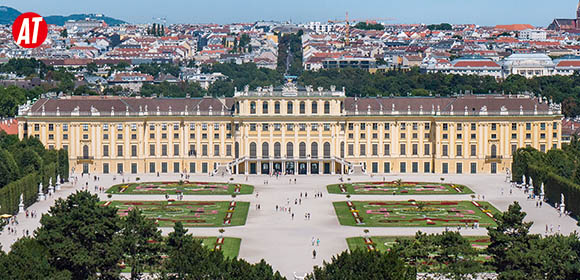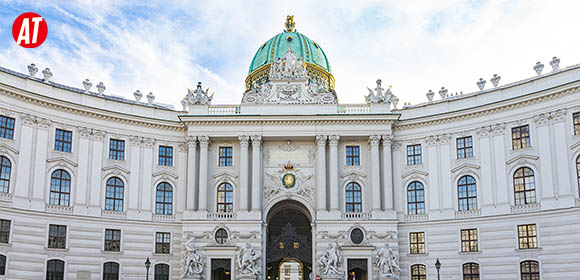
Vienna is the capital of Austria and was the political center of the Holy Roman Empire, the Austro-Hungarian Empire, and the Habsburg dynasty in history. It is home to royal palaces such as the Hofburg and the Schönbrunn Palace. Vienna is often called the City of Music, and so many architectural legacies are located and well preserved here on the romantic banks of the Danube.
The Palaces of the Habsburgs
From the 13th century until 1918, Vienna was ruled by Europe’s most prominent family, the Habsburgs. Their imprints can be seen everywhere in the city, including the Hofburg. With 18 wings, 19 courtyards and nearly 3,000 rooms, the Hofburg Palace is one of Vienna’s most popular tourist attractions, with exhibitions of royal life, including treasures and art collections.

Hofburg Palace
Massive Austrian Palace Complex
The Hofburg, which began in the 13th century, is an Austrian royal palace complex consisting of dozens of palaces and squares, including the Swiss Wing, Amalienburg and Heroes Square. The interior of the Hofburg houses the Sisi Museum, the Imperial Apartments, and exhibitions of royal treasures.

Austrian National Library / Prunksaal
The Magnificent Old Imperial Library
The Austrian National Library, with a collection of 13 million items including books, maps, and the papyrus collection, was formerly the royal library of the Habsburgs. The library's oldest hall, the Prunksaal, was built in 1723 in the Baroque style and features sculptures and frescoes from the 17th to 18th centuries.

Heldenplatz
Tribute to Austrian War Heroes
Heldenplatz (Heroes' Square) in Vienna is part of the Hofburg with statues of Prince Eugene and Archduke Charles, who fought off the Turkish and Napoleonic armies in the past and are considered heroes of Austria.
The Schönbrunn Palace in southwest Vienna was built in 1742 as the summer residence of the Habsburgs, where Princess Sissi (Empress Elisabeth) lived. In 1752, Maria Theresa, the only female ruler of the Habsburgs, acquired the Belvedere to display the royal collection of paintings, which was the former residence of Prince Eugen.

Schonbrunn Palace And Garden
Empress Sisi's Summer Residence
Schönbrunn Palace, the royal palace of the Austro-Hungarian Empire and the Habsburgs, was built with more than 1,400 rooms, including banquet halls, royal bedrooms and an orangery. Its gardens on the south side feature numerous fountains and sculptures.

Belvedere
Prince Eugene of Savoy's Residence
The Belvedere is a baroque palace complex in Vienna, consisting of the Upper Belvedere, the Lower Belvedere, and the Belvedere Garden. Originally the residence of Prince Eugene of Savoy, the Belvedere is now open as an art gallery with a collection of works by Klimt, Monet, Van Gogh, and other painters.
Churches in Vienna
St. Stephen’s Cathedral is one of the most historic churches in Vienna, known for its architectural excellence, collection of artworks, and its political and religious importance. Not far from St. Stephen’s Cathedral is St. Peter’s Church, which dates back to the 4th century and is the oldest church in Vienna, featuring numerous sculptures and decorations.

St. Stephen's Cathedral
National Symbol of Austria
St. Stephen's Cathedral is the symbol of Austria, located in the heart of Vienna. It has a Romanesque facade and a 136-meter-high Gothic tower. The church's collection includes the tomb of Frederick III and Triptychs of The Wiener Neustädter Altar.

St. Peter's Church
Magnificent Sculptures and Murals
St. Peter's Church in Vienna dates from the 4th century and the present Baroque church was completed in 1733. With its green dome and twin towers, the interior of St. Peter's Church is rich in ornate sculptures and decorations, and the oval dome features a large ceiling fresco of the Coronation of Our Lady.
There are also several churches in Vienna that have strong connections to the Habsburgs. The Karl Church was built by Emperor Charles VI to fulfill a promise made during the Plague. Emperor Franz Joseph I miraculously survived an assassination attempt in 1856, and as an expression of gratitude to God, he ordered the building of the Vienna Votive Church.

Karlskirche
Outstanding Baroque Church in Vienna
The Karlskirche in Vienna, also known as the St. Charles Church, was built in 1716 by the order of Emperor Charles VI. The facade of Karlskirche incorporates various elements such as Greek portico and Roman relief columns, and the sculptures of the church altar and the dome frescoes are created with the theme of St. Charles Borromeo.

Vienna Votive Church
A Failed Assassination Attempt
The Votive Church in Vienna was built in 1856 by order of Emperor Franz Josef I after he survived the assassination as an expression of his gratitude to God. The church building is in neo-Gothic style with the iconic twin towers, numerous frescoes and colorful stained glass windows inside.
City of Music
Vienna, known as the “City of Music”, is the home of such famous musicians as Johann Strauss Sr., Johann Strauss Jr. and many of Mozart’s best works were composed during his days in Vienna. The Vienna New Year’s Concert is considered an annual event by music lovers around the world, and every time the familiar melody of “The Blue Danube” plays in the Golden Hall (Musikverein), vivid images of valleys, fields, and beautiful landscapes on both sides of the Danube come to our minds.

Wiener Musikverein
The Celebrated New Year's Concert
The Wiener Musikverein is a concert hall officially known as the Viennese Music Association. Since 1939, the annual Vienna New Year's Concert has been held in the Musikverein, becoming an annual event for music lovers.

Danube - Vienna
River of A Familiar Melody
The Danube is the second largest river in Europe, and its course in Austria is approximately 358 kilometers long. The Danube runs through the Vienna metropolitan area, and this section of the waterway is flat and straight, with stunning scenery on both sides. The river was the inspiration for Austrian composer Johann Strauss II's waltz The Blue Danube.



































